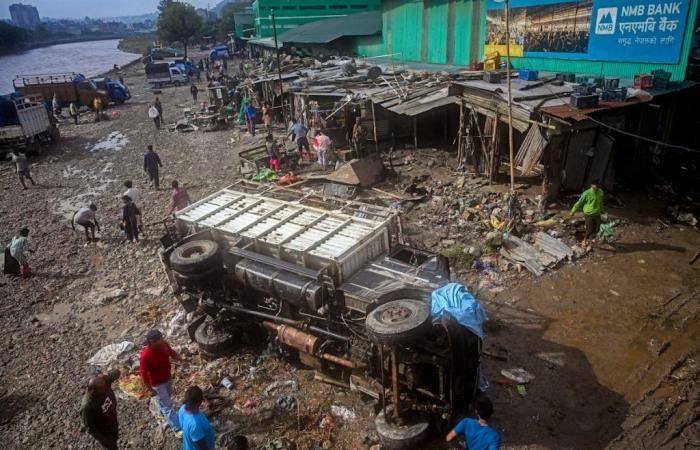Entire neighborhoods of Kathmandu were invaded by a tide of mud and debris of all kinds generated by the sudden and exceptional flooding of the Bagmati River.
AFP
The patient search for possible survivors continued on Monday in the districts of Kathmandu covered in mud by floods and landslides of an unprecedented scale, which left at least 200 dead.
During the night from Friday to Saturday, the capital of Nepal and a good part of the east and center of the country were subjected to a deluge not seen in twenty years at the end of the Asian summer monsoon season South.
Entire neighborhoods of Kathmandu were invaded by a tide of mud and debris of all kinds generated by the sudden and exceptional flood of the Bagmati river which crosses the valley.
“According to our latest figures, 200 people died, 127 were injured and 26 are still missing,” Interior Ministry spokesperson Rishi Ram Tiwari told AFP.
Many roads connecting Kathmandu to the rest of the country were submerged in a tide of brownish mud.
At least 35 of the victims were buried alive aboard three vehicles when a landslide covered one of these roads, south of the capital, he said.
“Our priority is search and rescue, including people who are stranded on the roads,” he added.
The Nepalese army, for its part, indicated that it had already carried out more than 4,000 evacuations, notably with helicopters, motorboats and lifeboats.
Bulldozers and other excavating machines were used to clear the roads.
The paralysis of the road network caused the first shortages of vegetables in the capital, the prices of which increased significantly.
“Informal neighborhoods”
“Usually, we receive 600 to 700 tonnes of vegetables every day, yesterday we only received 156 tonnes,” said Binay Shrestha, a wholesaler in one of Kathmandu’s main markets.
“Production is available, but it is blocked by the state of the roads,” he added.
In areas of the capital buried under a thick layer of mud, teams of booted rescuers were hard at work helping residents clean their homes and save what could be saved.
Nilkantha Pandey, from the humanitarian organization Care Nepal, stressed the urgency of providing the victims with drinking water and finding them temporary rehousing.
“For the most part, it is informal settlements that have been affected,” he said, “it is time to respond to these necessities and without delay.”
As noted by the International Center for Integrated Mountain Development (Icimod), the impact of the disaster was particularly devastating in these neighborhoods born from the uncontrolled urbanization of Kathmandu.
240 millimeters of rain
According to provisional data from the Department of Hydrology and Meteorology, stations in 14 districts had measured record rainfall in the twenty-four hours before Saturday morning.
A station at Kathmandu airport recorded 240 millimeters of rain, the highest level since 2002, it said.
Monsoons from June to September cause death and destruction across South Asia each year, but the number of deadly floods and landslides has increased in recent years.
Scientists say climate change has worsened their frequency and intensity.
Precipitation reduces in September, at the end of the monsoon season, ICIMOD climatologist Arun Bhakta Shrestha reminded AFP.
“Precipitation of this magnitude must be described as abnormal,” he said. “It’s an extreme climatic event (…) I probably see it as a consequence of climate change”
(afp)






